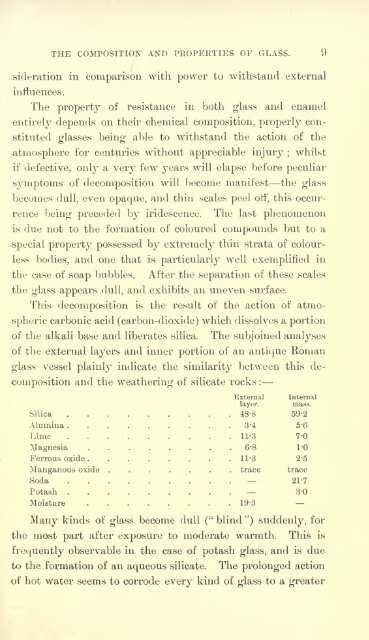Enamels and enamelling; an introduction to the preparation and ...
Enamels and enamelling; an introduction to the preparation and ...
Enamels and enamelling; an introduction to the preparation and ...
Create successful ePaper yourself
Turn your PDF publications into a flip-book with our unique Google optimized e-Paper software.
THE COMPOSITION AND PROPERTIES OF GLASS. 9<br />
'sideration in comparison with power <strong>to</strong> withst<strong><strong>an</strong>d</strong> external<br />
influences.<br />
The property of resist<strong>an</strong>ce in both glass <strong><strong>an</strong>d</strong> enamel<br />
entirely depends on <strong>the</strong>ir chemical composition, properly con-<br />
stituted glasses being able <strong>to</strong> withst<strong><strong>an</strong>d</strong> <strong>the</strong> action of <strong>the</strong><br />
atmosphere for centuries without appreciable injury ; whilst<br />
if defective, only a very few years will elapse before peculiar<br />
symp<strong>to</strong>ms of decomposition will become m<strong>an</strong>ifest <strong>the</strong> glass<br />
becomes dull, even opaque, <strong><strong>an</strong>d</strong> thin scales peel off, this occur-<br />
rence being preceded by iridescence. The last phenomenon<br />
is due not <strong>to</strong> <strong>the</strong> formation of coloured compounds but <strong>to</strong> a<br />
special property possessed by extremely thin strata of colour-<br />
less bodies, <strong><strong>an</strong>d</strong> one that is particularly well exemplified in<br />
<strong>the</strong> case of soap bubbles. After <strong>the</strong> separation of <strong>the</strong>se scales<br />
<strong>the</strong> glass appears dull, <strong><strong>an</strong>d</strong> exhibits <strong>an</strong> uneven surface.<br />
This decomposition is <strong>the</strong> result of <strong>the</strong> action of atmo-<br />
spheric carbonic acid (carbon-dioxide) which dissolves a portion<br />
of <strong>the</strong> alkali base <strong><strong>an</strong>d</strong> liberates silica. The subjoined <strong>an</strong>alyses<br />
of <strong>the</strong> external layers <strong><strong>an</strong>d</strong> inner portion of <strong>an</strong> <strong>an</strong>tique Rom<strong>an</strong><br />
glass vessel plainly indicate <strong>the</strong> similarity<br />
composition <strong><strong>an</strong>d</strong> <strong>the</strong> wea<strong>the</strong>ring<br />
of silicate rocks :<br />
between this de-<br />
External Internal<br />
layer.<br />
mass.<br />
Silica 48-8 59-2<br />
Alumina 3-4 5*6<br />
Lime 11-3 7'0<br />
Magnesia 6'8 1-0<br />
Ferrous oxide 11-3 2-5<br />
M<strong>an</strong>g<strong>an</strong>ous oxide trace trace<br />
Soda . . 21-7<br />
Potash 3-0<br />
Moisture 19-3<br />
M<strong>an</strong>y kinds of glass become dull (" blind ") suddenly, for<br />
<strong>the</strong> most part after exposure <strong>to</strong> moderate warmth. This is<br />
frequently observable in <strong>the</strong> case of potash glass,<br />
<strong><strong>an</strong>d</strong> is due<br />
<strong>to</strong> <strong>the</strong> formation of <strong>an</strong> aqueous silicate. The prolonged action<br />
of hot water seems <strong>to</strong> corrode every kind of glass <strong>to</strong> a greater
















